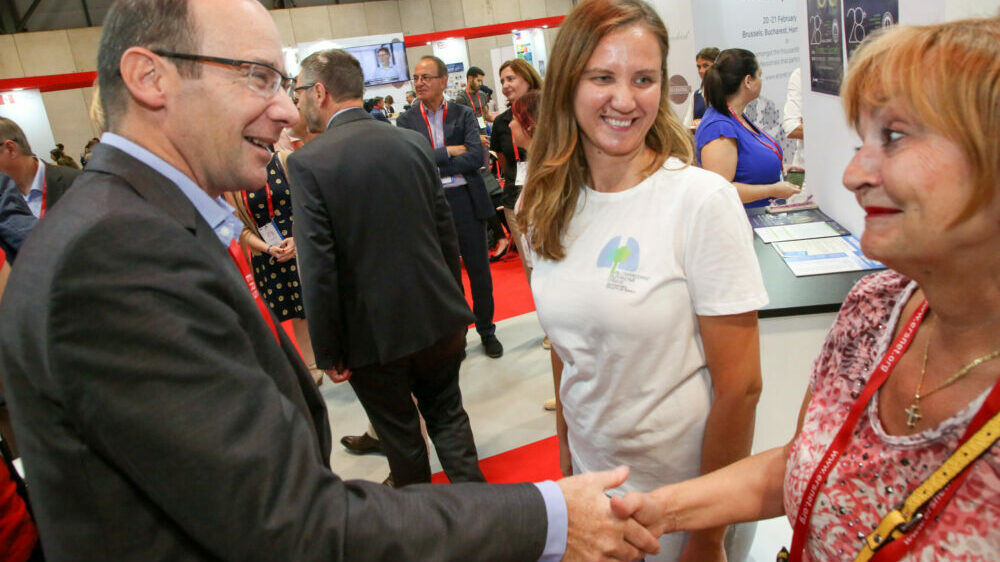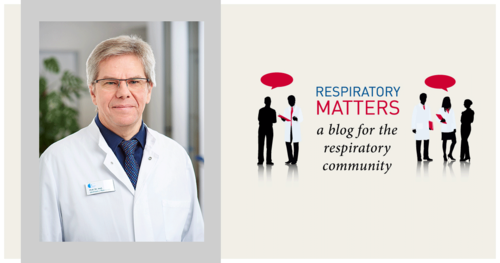A challenge for pulmonary medicine
The number of patients requiring long-term mechanical ventilation for chronic hypercapnic failure is rapidly increasing. Epidemiological factors and medical proceedings contribute to this development:
- Aging and the “obesity epidemic” are associated with the burden of multiple comorbidities in patients facing acute emergency situations or undergoing elective procedures.
- The prevalence of chronic obstructive pulmonary disease – one of the most important causes of chronic hypercapnic failure – has increased in recent years and is expected to become one of top five diagnoses in the future.
- Therapeutical options of intensive care have improved substantially in recent decades including organ replacement therapy, extra corporal oxygenation or decarboxylation, resuscitation and cardiac stabilisation.
However, not all patients can sufficiently overcome these critical situations. Some survive, but cannot be weaned from mechanical ventilation. Prolonged weaning and weaning failure become a major problem for individual patients and for healthcare systems, leading to important questions for daily patient care:
- Are there risk factors of weaning failure?
- What are the weaning impediments and how can they be solved?
- How should a structured, systematic weaning centre and procedure be organised?
- What are the challenges of mechanical ventilation at home or in nursing facilities?
- What are the ethical implications of long-term mechanical ventilation? Which patients should be ventilated over long periods? Are there indications to stop long-term mechanical ventilation?
What is respiratory failure?
The respiratory process can roughly be separated into two components:
Ventilation describes the transport of oxygen into and carbon dioxide and out of the lungs, i.e. the mechanical process of breathing air through the airways (inhalation and exhalation). It depends on the breathing regulation in the brain stem, the transmission of neural impulses via spinal cord, and peripheral nerves to the thoracic muscles and the skeleton. Any disorder of the ventilation leads to a reduction of minute ventilation and increases of carbon dioxide in the blood. This characterises acute or chronic hypercapnic failure. Typical underlying diseases of ventilatory failure include ischaemic or inflammatory damages of the brain stem, neurodegenerative or muscular disorders, such as amyotrophic lateral sclerosis, muscle dystrophy, traumatic damages of spinal cord or peripheral nerves, and thoraco-skeletal malformations, such as kyphoscoliosis.
Respiration describes the exchange of oxygen and carbon dioxide through the alveolar membrane into erythrocytes and organ tissues. Diseases of the lung parenchyma (pneumonia, lung fibrosis, emphysema), the pulmonary vessels (pulmonary hypertension), the blood and circulation (heart failure) affect the gas exchange and induce primarily induce hypoxia. They are described as acute or chronic hypoxic failure.
Risk factors of ventilatory failure
Patients suffering from chronic airway or lung diseases are predisposed to acute hypoxic or hypercapnic failure in acute medical emergencies or in elective surgical procedures. Due to common risk factors (smoking, age, obesity) additional cardiac, renal or neurological comorbidities further increase the risk of acute on chronic ventilatory failure.
Moreover, these constellations are associated with increased risk of failure from mechanical ventilation. A recent analysis of the German WeanNet data base showed that the median number of comorbidities in patients with prolonged weaning was five, the median age 70.8 years. While 59% of the patients suffered from arterial hypertension and 58.3% from COPD, one third was affected by coronary artery disease, renal failure, diabetes mellitus, heart failure and obesity [1]. It can be concluded that older age, chronic pulmonary diseases and chronic cardiac, metabolic and renal comorbidities predispose to long-term mechanical ventilation.
Weaning from mechanical ventilation: simple – prolonged – failing
The weaning process can be classified in three groups [2]:
- Group 1: Simple weaning successfully performed after the first spontaneous breathing trial and first extubation.
- Group 2: Difficult weaning, successful with the third spontaneous breathing trial or earlier or within seven days after the first failing spontaneous breathing trial.
- Group 3: Prolonged weaning, successful after at least three failing spontaneous breathing trials or later than seven days after the first failing spontaneous breathing trial.
Schönhofer et al. added three subgroups to group 3 in a national guideline [3]:
- Group 3a: Prolonged weaning without non-invasive ventilation.
- Group 3b: Prolonged weaning with non-invasive ventilation.
- Group 3c: Weaning failure.
The complexity of comorbidities, weaning impediments, necessities of professional specialisms, specific attitudes and competencies require a structured process. This includes clearly defined personal resources, technical facilities and standardised operational procedures. A formal review process of the infrastructure and a personal visitation are conditions of official certification by medical societies. Continuous reporting and re-evaluation, but also participation in scientific validation are further prerequisites of the accreditation process. The WeanNet database gathers information from centres of expertise in weaning which fulfil a battery of structural and organisational conditions and underwent a standardised certification process. First data show the effectiveness of the system in terms of patients’ outcome.
Impediments of weaning success
The structured process of weaning from long-term ventilation includes:
- Evaluation of the actual cause of weaning failure.
- Optimisation of the underlying diseases and comorbidities.
- Elimination of weaning impediments.
Acute diseases or organ dysfunctions often trigger hypoxic or hypercapnic respiratory failure in patients with underlying chronic pulmonary diseases. Therefore, the first step is the elimination of these factors. For example, the sufficient treatment of pulmonary or extrapulmonary infections, the stabilisation of acute cardiac or renal failure, the correction of fluid and acid-base balance, and the treatment of trauma. In addition, therapy of underlying comorbidities should be reevaluated and if necessary optimised. This includes pharmaceutical treatment but occasionally also organ replacement treatment such as haemodialysis or blood transfusion may be required.
Impediments of weaning success include weakness of pulmonary muscles, hypersecretion, sedation, increased airway resistance. Supportive measures include the reduction of sedative drugs and the transfusion of blood in patients with haemoglobin levels below 10 g/dl. A specialised interdisciplinary team of pulmonary physicians, supported by cardiologists and renal specialists and other disciplines, speech therapists, respiratory therapists, nurses, physiotherapists and psychologists should optimise parameters of mechanical ventilation, patient device interfaces, elimination of secretions, training of muscles and therapeutical support.
Long-term mechanical ventilation: Who and why?
Prolonged weaning and long-term mechanical ventilation have severe ethical implications. This prompts the questions: should the therapy be initiated in an individual patient at all, and if so, how it should be terminated? On a retrospective base, the meaningfulness of invasive ventilation is often questioned, especially in old or chronically ill patients with several comorbidities. However, the huge majority of patients undergoing surgeries or acute diseases can be extubated in weaning groups 1 or 2. Despite the unfavourable preconditions of older age, obesity and multiple comorbidities(as mentioned above), the WeanNet analyses demonstrated that certified centres dismiss 42.8% of patients with prolonged weaning (group 3) without further mechanical ventilation, 19.4% could be extubated but remained on non-invasive ventilation. 22.9% patients were dismissed from the hospital with long-term home invasive ventilation while 14.9% died in the hospital.
Thus, there is no rationale to generally exclude patients at risk of weaning failure from acute interventions and surgery. However, whenever possible, probable unfavourable outcome should be discussed with predisposed patients or their relatives. This may allow reasonable decisions based on the real or presumed patient’s will.
Several aspects may argue in favour of long-term mechanical ventilation:
- Giving time for a second weaning trial:
About 10% of those patients dismissed on invasive mechanical ventilation from specialised weaning centres improve under nursing conditions at home or in professional institutions over the long-term. This is due to the stabilisation of the social situation, improvement of respiratory muscle function and mobilisation or nutrition. Therefore, the option of secondary weaning should be re-evaluated on a regular base at least every three months.
- Given a chance for new quality of life:
The idea of becoming blind,deaf or loosing mobility is horrible for many people, as is imagining dependency on long-term invasive ventilation. However, the majority of patients newly affected with handicaps on vision, hearing or mobility get used to the situation and develop new levels of quality of life. This is also true for many awake and conscious mechanically ventilated patients. They can participate in social events, do limited amounts of homework and hobbies and communicate with relatives and friends. Thus, any prejudgement of non-livable conditions should be avoided as it remains exclusively on the self-assessment of affected patients.
- Giving time to the relatives:
Many partners or children of non-conscious long-term ventilated patients suffer substantially from the unexpected clinical situation. They are overstrained to decide if long-term ventilation should be continued. This process of consideration and decision often takes time, communication and discussions with friends, physicians, and religious or psychological advisors. Therefore, the continuation of long-term ventilation may be necessary to allow relatives for taking leave step-by-step.
In principal, the continuation of long-term invasive mechanical ventilation may be reasonable in these cases:
- If an awake and conscious patient subjectively benefits from the treatment, or
- If the primary weaning process failed but there is a chance for a secondary weaning trial after optimisation of nutrition, social and medical situation.
The decisions on initiation, continuation, and termination of invasive mechanical ventilation have to include the medical situation – e specially the chance of weaning and survival, the stability of organ function, and the cognitive situation – the individual wishes and beliefs of the patient. These complex situations often require intensive discussions in ethical committees of the hospital. It should be composed of all disciplines (nurses, physicians, psychologists and religious advisers) working together and having close relationships to the patient. A standardised process may guide the discussion and help relatives and physicians to decide.
About the author
Prof. Dr. med. Winfried J. Randerath graduated from Heinrich Heine University, Düsseldorf, Germany and became a specialist registrar in internal medicine, pneumology and sleep medicine. He qualified as a professor with a thesis on “Selfadjusting, Automatic CPAP Therapy Based on Impedance” (University Witten/Herdecke).
Since October 2003 he has been medical director of the Bethanien Hospital, Solingen, Germany, a clinic specialised in pneumology, sleep medicine and pulmonary intensive care. He is also the director of the Institute for Pneumology at the University of Cologne, Germany. He serves as Secretary General for the German Society of Pneumology (DGP) and is a board member of the German Society for Sleep Research and Sleep Medicine. He also chairs the local sleep society (NRW GSM).
On a European basis he chairs Group 4.02 “Sleep and Control of Breathing” at the European Respiratory Society. He has been/is the head of ERS-task forces on “Sleep and Stroke”, “Definition, discrimination, diagnosis, and treatment of central breathing disturbances during sleep”, “Non-CPAP Therapy in Obstructive Sleep Apnoea”, and “Pathophysiology, Diagnosis and Treatment of Central Sleep Apnoea”.
His main research activities focus on differentiation of obstructive and central sleep apnoea, interaction of sleep apnoea and the heart, pulmonary intensive care and chronic respiratory failure.
References
- WeanNet Study G, WeanNet Study G, Schönhofer B, Schönhofer B, Geiseler J, Geiseler J, Herth F, Herth F, Jany B, Jany B, Pfeifer M, Pfeifer M, Westhoff M, Westhoff M. WeanNet: Das Netzwerk von Weaning-Einheiten der Deutschen Gesellschaft für Pneumologie und Beatmungsmedizin (DGP). Dtsch med Wochenschr 2016: 141(18): e166-e172.
- Boles JM, Bion J, Connors A, Herridge M, Marsh B, Melot C, Pearl R, Silverman H, Stanchina M, Vieillard-Baron A, Welte T. Weaning from mechanical ventilation. The European Respiratory Journal : official Journal of the European Society for Clinical Respiratory Physiology 2007: 29(5): 1033-1056.
- Schonhofer B, Geiseler J, Dellweg D, Moerer O, Barchfeld T, Fuchs H, Karg O, Rosseau S, Sitter H, Weber-Carstens S, Westhoff M, Windisch W. [Prolonged weaning: S2k-guideline published by the German Respiratory Society]. Pneumologie 2014: 68(1): 19-75.





